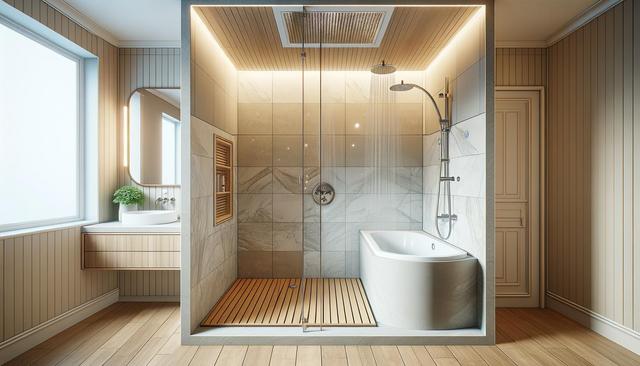Creative Tub to Shower Conversion Ideas for a Modern Bathroom
Looking for tub to shower conversion ideas? This affordable upgrade improves accessibility and modernizes your bathroom. Discover design tips and space-saving solutions, enhancing your bathroom’s functionality while increasing home value with minimal investment.

Maximizing Small Spaces with Corner Showers
One of the most practical tub to shower conversion ideas for compact bathrooms is installing a corner shower. This layout not only saves space but also opens up the room, making it feel larger and more breathable. Corner showers are available in various shapes, such as neo-angle or curved designs, and can be customized with frameless glass doors to maintain visual openness. For homeowners working with tight dimensions, this is a space-efficient solution that doesn’t sacrifice comfort or aesthetics.
Incorporating built-in storage options is also key to optimizing small areas. Consider recessed shelves or corner caddies integrated into the shower walls. These keep your toiletries organized without cluttering the space. Additionally, choosing light-toned tiles and reflective surfaces can help amplify natural and artificial light, creating the illusion of a bigger bathroom.
Other tips for small bathroom conversions include:
- Installing sliding or bi-fold shower doors instead of swinging ones
- Using wall-mounted fixtures to free up floor space
- Opting for a single-slab shower base to simplify cleaning and reduce visual clutter
Enhancing Accessibility with Walk-In Showers
For individuals looking to improve mobility and ease of use, converting a bathtub into a walk-in shower is a practical and stylish choice. Walk-in showers offer step-free entry, which is ideal for seniors or anyone with physical limitations. These conversions can be designed with safety and accessibility in mind—without compromising visual appeal.
Features like grab bars, non-slip flooring, and bench seating significantly enhance safety. A curbless shower entry, where the floor is continuous and level, eliminates the need to step over a ledge, reducing the risk of falls. Handheld showerheads and easy-to-reach controls further improve user convenience.
Consider these accessible design elements:
- Textured floor tiles for better grip
- Contrasting tile colors to define wet zones
- Wall niches at reachable heights for toiletries
Not only do these features enhance usability, but they also contribute to a sleek, spa-like aesthetic that appeals to a wide range of homeowners.
Modern Materials and Finishes for a Fresh Look
Material selection plays a significant role in the success of a tub to shower conversion. Today’s design trends favor clean lines, durable surfaces, and low-maintenance finishes. For a contemporary bathroom refresh, consider using large-format porcelain tiles, engineered stone panels, or acrylic wall systems. These materials resist moisture, are easy to clean, and come in a variety of patterns and colors to suit your style.
Glass enclosures, especially frameless ones, offer a minimalist look and allow light to flow freely throughout the room. This not only enhances the overall brightness but also makes the shower area feel more expansive. Matte black fixtures, brushed nickel, or chrome finishes can complement modern aesthetics and work well with neutral or bold color schemes alike.
Popular material combinations include:
- White subway tiles with black hardware
- Natural stone-look tiles with warm brass fixtures
- Monochromatic walls paired with wood accents
When planning your conversion, don’t overlook the importance of grout color and layout patterns, as these subtle elements can dramatically influence the final appearance.
Incorporating Eco-Friendly Features
Environmentally conscious homeowners may want to consider sustainability when planning their tub to shower conversion. Water-saving fixtures and eco-friendly materials are both smart and responsible choices. Low-flow showerheads and faucets can significantly reduce water usage without compromising performance, while recycled or sustainably sourced tiles contribute to a greener bathroom renovation.
Installing a thermostatic shower valve helps maintain water temperature efficiently, reducing waste from readjusting hot and cold settings. LED lighting around the shower area can offer energy savings while enhancing ambiance and visibility. Moreover, choosing durable, long-lasting materials minimizes the need for replacements and reduces environmental impact over time.
Environmentally friendly upgrades to consider:
- WaterSense-labeled showerheads
- Recycled glass or porcelain tiles
- VOC-free adhesives and sealants
Going green in the bathroom doesn’t mean sacrificing style. Many eco-conscious products are designed with modern aesthetics in mind, allowing you to create a space that is both functional and environmentally responsible.
Custom Features to Personalize Your Shower Space
One of the advantages of converting a tub to a shower is the opportunity to tailor the space to your needs and preferences. Customization options range from layout and materials to specialized features that enhance comfort and utility. Whether you’re aiming for a luxurious feel or practical functionality, there are plenty of ways to personalize your new shower area.
Consider integrating smart technology, such as digital temperature controls or Bluetooth speakers, for a modern touch. If you enjoy spa-like experiences, a rainfall showerhead or body jets can elevate your daily routine. For storage, built-in niches, floating shelves, or even a bench with hidden compartments can offer both convenience and style.
Unique customization ideas include:
- Accent walls with mosaic or textured tiles
- Custom lighting schemes with dimmers or color-changing LEDs
- Dual showerheads for multiple users or personalized settings
Ultimately, the goal is to create a shower space that reflects your lifestyle while improving the overall efficiency and appeal of your bathroom.
Conclusion: Transform Your Bathroom with Purpose
Converting a tub to a shower is more than just a visual update—it’s a functional improvement that can enhance daily living, support accessibility, and increase your home’s appeal. Whether you’re working with a compact space or aiming for a high-end retreat, there are numerous ideas and design strategies to guide your renovation. By focusing on space optimization, modern materials, eco-friendly features, and personalized elements, you can create a bathroom that aligns with your needs and values. Thoughtful planning and professional execution can ensure your new shower design delivers long-term satisfaction and convenience.